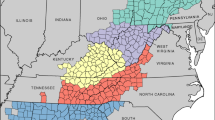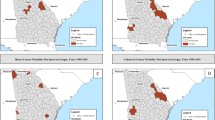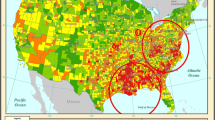Abstract
Purpose
The goals of this study were to identify geographic and racial/ethnic variation in breast cancer mortality, and evaluate whether observed geographic differences are explained by county-level characteristics.
Methods
We analyzed data on breast cancer deaths among women in 3,108 contiguous United States (US) counties from years 2000 through 2015. We applied novel geospatial methods and identified hot spot counties based on breast cancer mortality rates. We assessed differences in county-level characteristics between hot spot and other counties using Wilcoxon rank-sum test and Spearman correlation, and stratified all analysis by race/ethnicity.
Results
Among all women, 80 of 3,108 (2.57%) contiguous US counties were deemed hot spots for breast cancer mortality with the majority located in the southern region of the US (72.50%, p value < 0.001). In race/ethnicity-specific analyses, 119 (3.83%) hot spot counties were identified for NH-Black women, with the majority being located in southern states (98.32%, p value < 0.001). Among Hispanic women, there were 83 (2.67%) hot spot counties and the majority was located in the southwest region of the US (southern = 61.45%, western = 33.73%, p value < 0.001). We did not observe definitive geographic patterns in breast cancer mortality for NH-White women. Hot spot counties were more likely to have residents with lower education, lower household income, higher unemployment rates, higher uninsured population, and higher proportion indicating cost as a barrier to medical care.
Conclusions
We observed geographic and racial/ethnic disparities in breast cancer mortality: NH-Black and Hispanic breast cancer deaths were more concentrated in southern, lower SES counties.




Similar content being viewed by others
References
Richardson LC et al (2016) Patterns and trends in age-specific black-white differences in breast cancer incidence and mortality: United States, 1999–2014. MMWR Morb Mortal Wkly Rep 65(40):1093–1098
Jemal A et al (2017) Annual Report to the Nation on the Status of Cancer, 1975–2014, featuring survival. J Natl Cancer Inst. https://doi.org/10.1093/jnci/djx030
Carey LA et al (2006) Race, breast cancer subtypes, and survival in the Carolina Breast Cancer Study. JAMA 295(21):2492–2502
Barry J, Breen N (2005) The importance of place of residence in predicting late-stage diagnosis of breast or cervical cancer. Health Place 11(1):15–29
Wang F et al (2008) Late-stage breast cancer diagnosis and health care access in Illinois. Prof Geogr 60(1):54–69
Akinyemiju T et al (2016) Racial disparities in individual breast cancer outcomes by hormone-receptor subtype, area-level socio-economic status and healthcare resources. Breast Cancer Res Treat 157(3):575–586
Bradley CJ, Given CW, Roberts C (2001) Disparities in cancer diagnosis and survival. Cancer 91(1):178–188
Bradley CJ, Given CW, Roberts C (2002) Race, socioeconomic status, and breast cancer treatment and survival. J Natl Cancer Inst 94(7):490–496
Meliker JR et al (2009) Breast and prostate cancer survival in Michigan: can geographic analyses assist in understanding racial disparities? Cancer 115(10):2212–2221
Pruitt SL et al (2015) Residential racial segregation and mortality among black, white, and Hispanic urban breast cancer patients in Texas, 1995 to 2009. Cancer 121(11):1845–1855
Ward E et al (2004) Cancer disparities by race/ethnicity and socioeconomic status. CA Cancer J Clin 54(2):78–93
Dai D (2010) Black residential segregation, disparities in spatial access to health care facilities, and late-stage breast cancer diagnosis in metropolitan Detroit. Health Place 16(5):1038–1052
Haas JS et al (2008) Racial segregation and disparities in breast cancer care and mortality. Cancer 113(8):2166–2172
Kuo TM, Mobley LR, Anselin L (2011) Geographic disparities in late-stage breast cancer diagnosis in California. Health Place 17(1):327–334
Gumpertz ML et al (2006) Geographic patterns of advanced breast cancer in Los Angeles: associations with biological and sociodemographic factors (United States). Cancer Causes Control 17(3):325–339
Baquet CR, Commiskey P (2000) Socioeconomic factors and breast carcinoma in multicultural women. Cancer 88(5 Suppl):1256–1264
Li CI, Malone KE, Daling JR (2003) Differences in breast cancer stage, treatment, and survival by race and ethnicity. Arch Intern Med 163(1):49–56
McBride R et al (2007) Within-stage racial differences in tumor size and number of positive lymph nodes in women with breast cancer. Cancer 110(6):1201–1208
Canto MT, Anderson WF, Brawley O (2001) Geographic variation in breast cancer mortality for white and black women: 1986–1995. CA Cancer J Clin 51(6):367–370
Chien LC, Yu HL, Schootman M (2013) Efficient mapping and geographic disparities in breast cancer mortality at the county-level by race and age in the U.S. Spat Spatiotemporal Epidemiol 5:27–37
Grann V et al (2006) Regional and racial disparities in breast cancer-specific mortality. Soc Sci Med 62(2):337–347
Markossian TW, Hines RB, Bayakly R (2014) Geographic and racial disparities in breast cancer-related outcomes in Georgia. Health Serv Res 49(2):481–501
Mobley LR et al (2017) Modeling geospatial patterns of late-stage diagnosis of breast cancer in the US. Int J Environ Res Public Health 14(5):484
Mokdad AH et al (2017) Trends and patterns of disparities in cancer mortality among US Counties, 1980–2014. JAMA 317(4):388–406
Scott L, Mobley LR, Il’yasova D (2017) Geospatial analysis of inflammatory breast cancer and associated community characteristics in the United States. Int J Environ Res Public Health 14(4):404
Tatalovich Z et al (2015) Geographic disparities in late stage breast cancer incidence: results from eight states in the United States. Int J Health Geogr 14:31
Tian N, Wilson JG, Zhan FB (2011) Spatial association of racial/ethnic disparities between late-stage diagnosis and mortality for female breast cancer: where to intervene? Int J Health Geogr 10:24
CDC (2016) Wide-ranging online data for epidemiologic research (CDC-Wonder). http://wonder.cdc.gov Accessed 15 May 2016
Manson S et al (2017) Minnesota population center: national historical geographic information system: version 2.0. University of Minnesota, Minneapolis
University of Wisconsin Population Health Institute (2016) County health rankings & roadmaps
Kirchhoff AC, Hart G, Campbell EG (2014) Rural and urban primary care physician professional beliefs and quality improvement behaviors. J Rural Health 30(3):235–243
Gruca TS, Pyo TH, Nelson GC (2016) Improving rural access to orthopaedic care through visiting consultant clinics. J Bone Joint Surg Am 98(9):768–774
Census (2016) Geographic terms and concepts: census divisions and census regions. https://www.census.gov/geo/reference/gtc/gtc_census_divreg.html Accessed 15 May 2016
Wartenberg D (2001) Investigating disease clusters: why, when, and how? J R Stat Soc A 164(Part 1):13–22
Moore JX, Donnelly JP, Griffin R, Howard G, Safford MM, Wang HE (2016) Defining sepsis mortality clusters in the United States. Crit Care Med 44(7):1380–1387
Anselin L (1995) Local indicators of spatial association: LISA. Geogr Anal 27:93–115
Getis A, Ord K (1992) The analysis of spatial association by use of distance statistics. Geogr Anal 24:189–206
Nassel AF, Root ED, Haukoos JS, McVaney K, Colwell C, Robinson J, Eigel B, Magid DJ, Sasson C (2014) Multiple cluster analysis for the identification of high-risk census tracts for out-of-hospital cardiac arrest (OHCA) in Denver, Colorado. Resuscitation 85:1667–1673
Anselin L (2004) Exploring spatial data with GeoDa: a workbook. University of Illinois, Urbana-Champaign
Li H, Calder CA, Cressie NAC (2007) Beyond Moran’s I: testing for spatial dependence based on the spatial autoregressive model. Geogr Anal 39:357–375
Li H, Calder CA, Cressie NAC (2012) One-step estimation of spatial dependence parameters: properties and extensions of the APLE statistic. J Multivariate Anal 105:68–84
Schootman M et al (2009) The role of poverty rate and racial distribution in the geographic clustering of breast cancer survival among older women: a geographic and multilevel analysis. Am J Epidemiol 169(5):554–561
Schootman M et al (2010) Temporal trends in geographic disparities in small-area breast cancer incidence and mortality, 1988 to 2005. Cancer Epidemiol Biomarkers Prev 19(4):1122–1131
Akinyemiju T, Meng Q, Vin-Raviv N (2016) Race/ethnicity and socio-economic differences in colorectal cancer surgery outcomes: analysis of the nationwide inpatient sample. BMC Cancer 16:715
Akinyemiju TF et al (2013) Individual and neighborhood socioeconomic status and healthcare resources in relation to black-white breast cancer survival disparities. J Cancer Epidemiol 2013:490472
Akinyemiju TF et al (2015) Race/ethnicity and socio-economic differences in breast cancer surgery outcomes. Cancer Epidemiol 39(5):745–751
Damle RN et al (2016) Examination of racial disparities in the receipt of minimally invasive surgery among a national cohort of adult patients undergoing colorectal surgery. Dis Colon Rectum 59(11):1055–1062
Fedewa SA et al (2011) Race and ethnicity are associated with delays in breast cancer treatment (2003–2006). J Health Care Poor Underserved 22(1):128–141
Fedewa SA et al (2010) Delays in adjuvant chemotherapy treatment among patients with breast cancer are more likely in African American and Hispanic populations: a national cohort study 2004–2006. J Clin Oncol 28(27):4135–4141
Freedman RA et al (2011) The association of race/ethnicity, insurance status, and socioeconomic factors with breast cancer care. Cancer 117(1):180–189
Hershman DL et al (2015) Household net worth, racial disparities, and hormonal therapy adherence among women with early-stage breast cancer. J Clin Oncol 33(9):1053–1059
Schmid M et al (2016) Racial Differences in the surgical care of medicare beneficiaries with localized prostate cancer. JAMA Oncol 2(1):85–93
Shavers VL, Brown ML (2002) Racial and ethnic disparities in the receipt of cancer treatment. J Natl Cancer Inst 94(5):334–357
Sheppard VB et al (2015) Disparities in breast cancer surgery delay: the lingering effect of race. Ann Surg Oncol 22(9):2902–2911
Wang EH et al (2016) Disparities in treatment of patients with high-risk prostate cancer: results from a population-based cohort. Urology 95:88–94
Torre LA, Siegel RL, Jemal A (2016) Lung cancer statistics. Adv Exp Med Biol 893:1–19
Casper ML, Wing S, Anda RF, Knowles M, Pollard RA (1995) The shifting stroke belt: changes in the geographic pattern of stroke mortality in the United States, 1962 to 1988. Stroke 26(5):755–760
Moore JX et al (2016) Defining sepsis mortality clusters in the United States. Crit Care Med 44(7):1380–1387
Chang BA, Pearson WS, Owusu-Edusei K Jr (2017) Correlates of county-level nonviral sexually transmitted infection hot spots in the US: application of hot spot analysis and spatial logistic regression. Ann Epidemiol 27(4):231–237
Moore JX, Akinyemiju T, Wang HE (2017) Pollution and regional variations of lung cancer mortality in the United States. Cancer Epidemiol 49:118–127
Karp DN et al (2016) Reassessing the Stroke belt: using small area spatial statistics to identify clusters of high stroke mortality in the United States. Stroke 47(7):1939–1942
Aschengrau A, Paulu C, Ozonoff D (1998) Tetrachloroethylene-contaminated drinking water and the risk of breast cancer. Environ Health Perspect 106(Suppl 4):947–953
Terry PD, Miller AB, Rohan TE (2002) Cigarette smoking and breast cancer risk: a long latency period? Int J Cancer 100(6):723–728
Petralia SA et al (1999) Risk of premenopausal breast cancer in association with occupational exposure to polycyclic aromatic hydrocarbons and benzene. Scand J Work Environ Health 25(3):215–221
Akinyemiju T et al (2016) Disparities in the prevalence of comorbidities among US adults by state Medicaid expansion status. Prev Med 88:196–202
Funding
Funding was provided by National Cancer Institute (Grant Nos. R25 CA47888, U54 CA118948, and T32190194), Foundation for Barnes-Jewish Hospital, and National Institute for Nursing Research ( Grant No R01-NR012726).
Author information
Authors and Affiliations
Corresponding author
Electronic supplementary material
Below is the link to the electronic supplementary material.
Supplemental Figure 1
: Getis-Ord (Gi*) for breast cancer mortality hot spots, among all women in the contiguous United States, years 2000 – 2015. (TIF 4934 KB)
Supplemental Figure 2
: Local indicators of spatial association (LISA) for breast cancer mortality, among all women in the contiguous United States, years 2000 – 2015. (TIF 4710 KB)
Supplemental Figure 3
: Breast cancer mortality using spatial Empirical Bayes (EB) smoothed rates quintiles, among all women in the Contiguous United States, years 2000 – 2015. (TIF 5027 KB)
Supplemental Figure 4
: Getis-Ord (Gi*) for breast cancer mortality hot spots, among NH-Black women in the contiguous United States, years 2000 – 2015. (TIF 6918 KB)
Supplemental Figure 5
: Local indicators of spatial association (LISA) for breast cancer mortality, among NH-Black women in the contiguous United States, years 2000 – 2015. (TIF 6565 KB)
Supplemental Figure 6
: Breast cancer mortality using spatial Empirical Bayes (EB) smoothed rates quintiles, among NH-Black women in the Contiguous United States, years 2000 – 2015. (TIF 7139 KB)
Supplemental Figure 7
: Getis-Ord (Gi*) for breast cancer mortality hot spots, among Hispanic women in the contiguous United States, years 2000 – 2015. (TIF 5983 KB)
Supplemental Figure 8
: Local indicators of spatial association (LISA) for breast cancer mortality, among Hispanic women in the contiguous United States, years 2000 – 2015. (TIF 5618 KB)
Supplemental Figure 9
: Breast cancer mortality using spatial Empirical Bayes (EB) smoothed rates quintiles, among Hispanic women in the Contiguous United States, years 2000 – 2015. (TIF 6262 KB)
Supplemental Figure 10
: Getis-Ord (Gi*) for breast cancer mortality hot spots, among NH-White women in the contiguous United States, years 2000 – 2015. (TIF 5442 KB)
Supplemental Figure 11
: Local indicators of spatial association (LISA) for breast cancer mortality, among NH-White women in the contiguous United States, years 2000 – 2015. (TIF 5459 KB)
Supplemental Figure 12
: Breast cancer mortality using spatial Empirical Bayes (EB) smoothed rates quintiles, among NH-White women in the Contiguous United States, years 2000 – 2015. (TIF 5811 KB)
Rights and permissions
About this article
Cite this article
Moore, J.X., Royston, K.J., Langston, M.E. et al. Mapping hot spots of breast cancer mortality in the United States: place matters for Blacks and Hispanics. Cancer Causes Control 29, 737–750 (2018). https://doi.org/10.1007/s10552-018-1051-y
Received:
Accepted:
Published:
Issue Date:
DOI: https://doi.org/10.1007/s10552-018-1051-y




